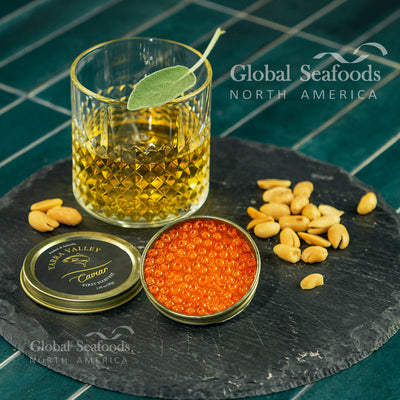Discover the History of Red Caviar – Luxury, Tradition, and Global Appeal

The Rich History of Red Caviar: A Global Culinary Treasure
What Makes Red Caviar a Timeless Culinary Gem?
Red caviar, commonly known as salmon roe, is more than just a delicacy. Its vibrant appearance, rich flavor, and fascinating history have made it a symbol of luxury and tradition across the globe. This article explores the origins of red caviar, its rise to international fame, and how sustainable farming practices are preserving its legacy.
A Regal Beginning: Red Caviar’s Russian Origins
Red Caviar in Russian History
Red caviar has deep roots in Russian culture, dating back to the 12th century. Fishermen along the Caspian and Black Sea coasts first discovered salmon and sturgeon roe as a delicacy. Its popularity grew rapidly among the Russian nobility, who prized it as a symbol of wealth and sophistication.
A Cultural Staple
In Russia, red caviar became a staple for special occasions and grand feasts. Paired with blinis, vodka, and other traditional dishes, it was celebrated as a culinary treasure. Even today, red caviar remains a centerpiece of Russian cuisine, particularly during holidays like New Year’s Eve.
From Local Treasure to Global Sensation
European Aristocracy Embraces Caviar
By the 19th century, red caviar crossed Russian borders and charmed European elites. It graced the tables of royal banquets in France, England, and beyond. The vibrant red hue and delicate, briny flavor made it an instant favorite.
Popularity in the U.S. and Japan
In the 20th century, red caviar found a new audience in the United States and Japan. The rise of sushi culture in Japan introduced red caviar as a staple ingredient, known as ikura. In the U.S., red caviar became synonymous with gourmet dining, served in upscale restaurants and at luxurious events.
The Move Toward Sustainable Caviar Production
Decline of Wild Sturgeon and Overfishing
With the increasing global demand for caviar, overfishing became a significant concern. Wild sturgeon populations in the Caspian Sea, a primary source of caviar, faced a sharp decline.
Rise of Sustainable Aquaculture
Modern aquaculture methods have transformed the production of red caviar. Farms now breed salmon and trout in controlled environments, ensuring steady supplies while protecting wild fish populations. This shift has made red caviar more accessible while promoting environmental sustainability.
Benefits of Farmed Caviar
- Eco-Friendly: Reduces pressure on wild populations.
- Consistent Quality: Monitored conditions ensure premium flavor and texture.
- Ethical Practices: Transparent processes prioritize sustainability.
For premium, sustainably sourced red caviar, visit Global Seafoods.
Culinary Applications: Red Caviar’s Modern Appeal
Traditional Uses
Red caviar’s versatility makes it a star ingredient in both traditional and modern dishes.
- Blinis and Crème Fraîche: A classic Russian pairing.
- Sushi Rolls and Sashimi: An integral part of Japanese cuisine.
- Seafood Platters: Enhances lobster, crab, and shrimp dishes.
Innovative Creations
Chefs around the world experiment with red caviar in new ways:
- Salads: Adds elegance to fresh greens and citrus vinaigrettes.
- Pasta: Tossed into creamy sauces for a luxurious twist.
- Cocktails: Serves as a striking garnish for martinis and champagne.
Global Consumption of Red Caviar
Leading Countries in Red Caviar Demand
- Russia: Red caviar remains a beloved delicacy for holidays and celebrations.
- Japan: Sushi enthusiasts incorporate red caviar into countless dishes.
- United States: A growing appreciation for luxury foods drives demand.
- France: Red caviar is a staple in gourmet cooking.
- Germany: Popular for festive occasions and fine dining.
FAQs About Red Caviar
Q1: What is red caviar made from?
A: Red caviar comes from salmon roe. Varieties include king salmon, chum salmon, and coho salmon roe.
Q2: Is red caviar sustainable?
A: Yes, when sourced from certified farms that follow sustainable aquaculture practices.
Q3: How should I store red caviar?
A: Store it in the coldest part of your fridge at 28–32°F (-2–0°C) and consume it within three days of opening.
Q4: Can I freeze red caviar?
A: Freezing is not recommended for serving fresh, but it can be frozen for use in cooking.
Q5: What are the best food pairings with red caviar?
A: Pair it with champagne, vodka, smoked salmon, or creamy pasta dishes.
Conclusion: Red Caviar’s Enduring Legacy
From its noble origins in Russian tradition to its role in modern gourmet cuisine, red caviar has transcended borders and time. Its vibrant flavor, nutritional benefits, and cultural significance continue to captivate food lovers worldwide.
Whether enjoyed on blinis, sushi, or innovative dishes, red caviar offers an unparalleled culinary experience. Explore sustainably sourced options from Global Seafoods and bring this timeless delicacy to your table.
Explore More:
- Chum Salmon Caviar Soft Shell
- Coho Salmon Caviar
- Golden Pearls Brook Trout Caviar
- Rainbow Trout Pearls
Also in News

How to Make Sea Bream Sushi With Dry-Aged Tuna & Crab Roll — Step-by-Step With Chef Joshua
A complete guide to making Sea Bream sushi at home, including filleting, curing, slicing, and building a Dry-Aged Tuna & Crab sushi roll. Chef Joshua shares professional tips for restaurant-quality results.

Boiled Crab for Game Night: Everything You Need for a Perfect Seafood Party
Take your game night to the next level with a Boiled crab party. Learn the best recipes, cooking tips, and hosting hacks for a memorable seafood feast.

Boiled Crab for Date Night: A Romantic Guide to the Perfect Seafood Feast
Make your next date night unforgettable with a romantic Boiled crab experience. This guide covers everything you need to know, from ambiance to the best crab varieties.








